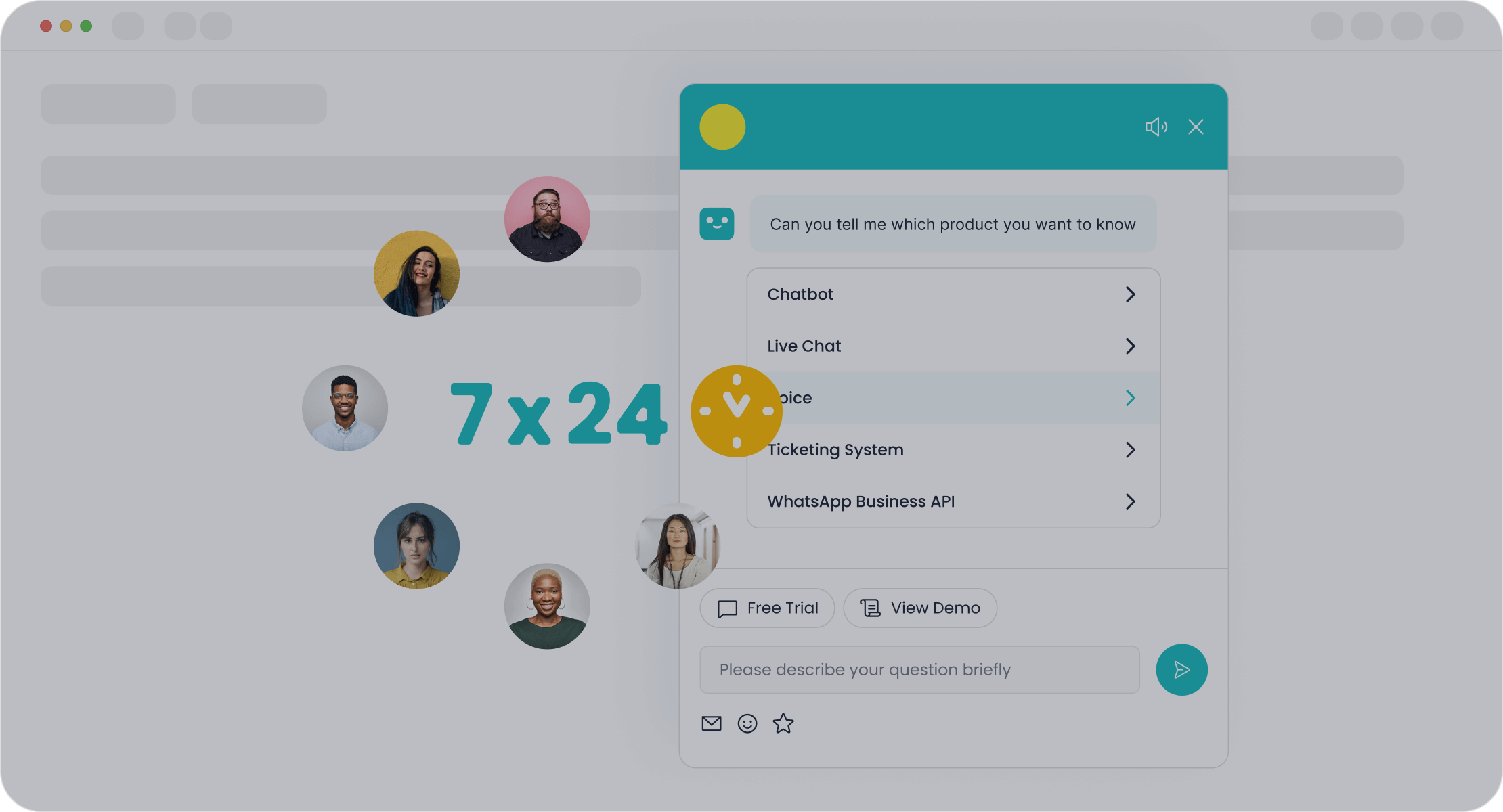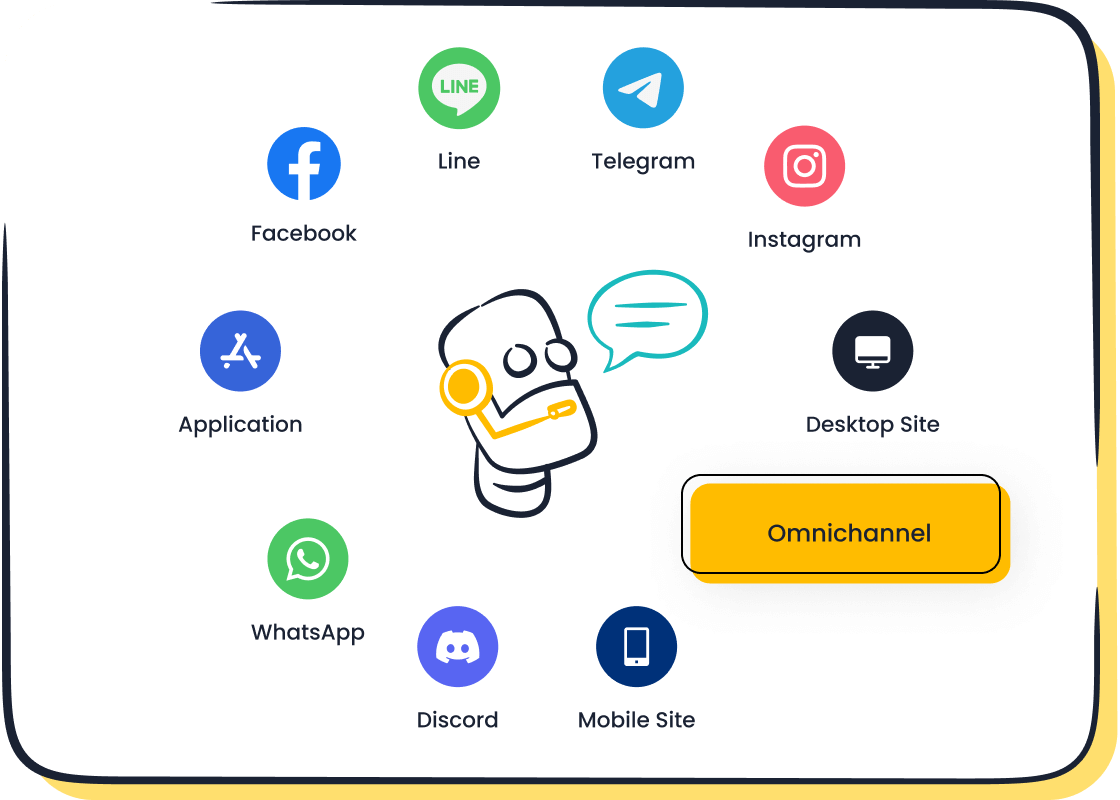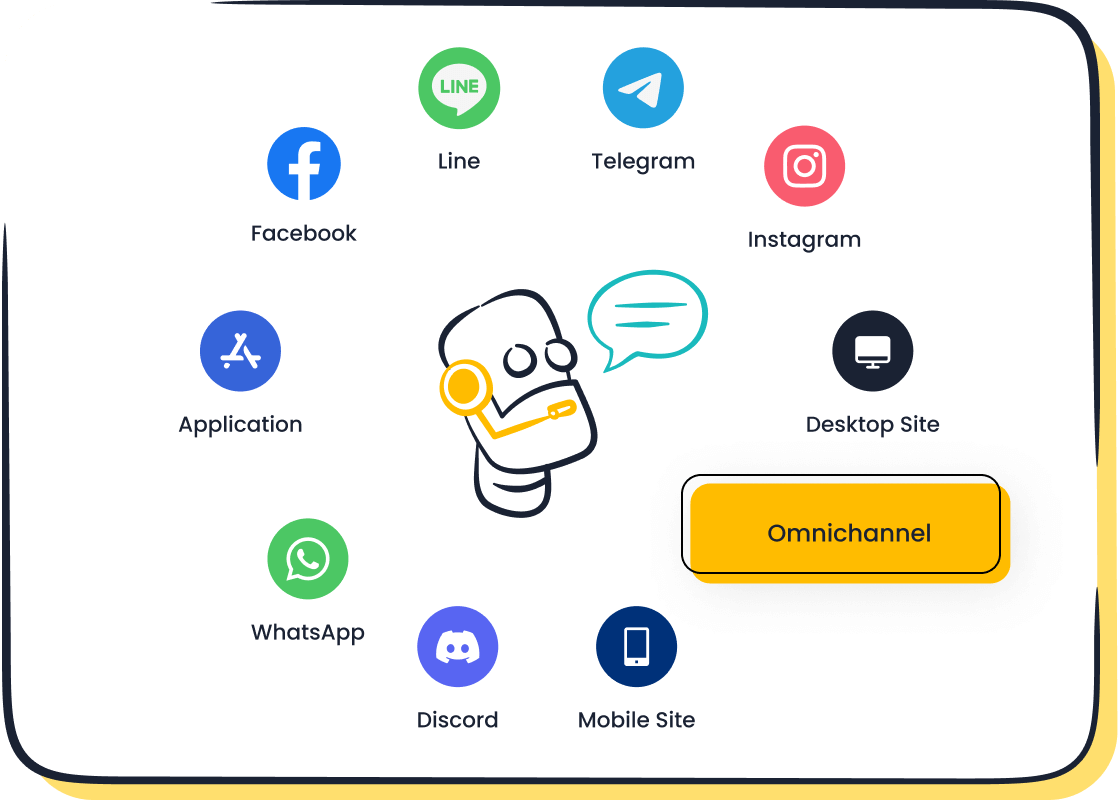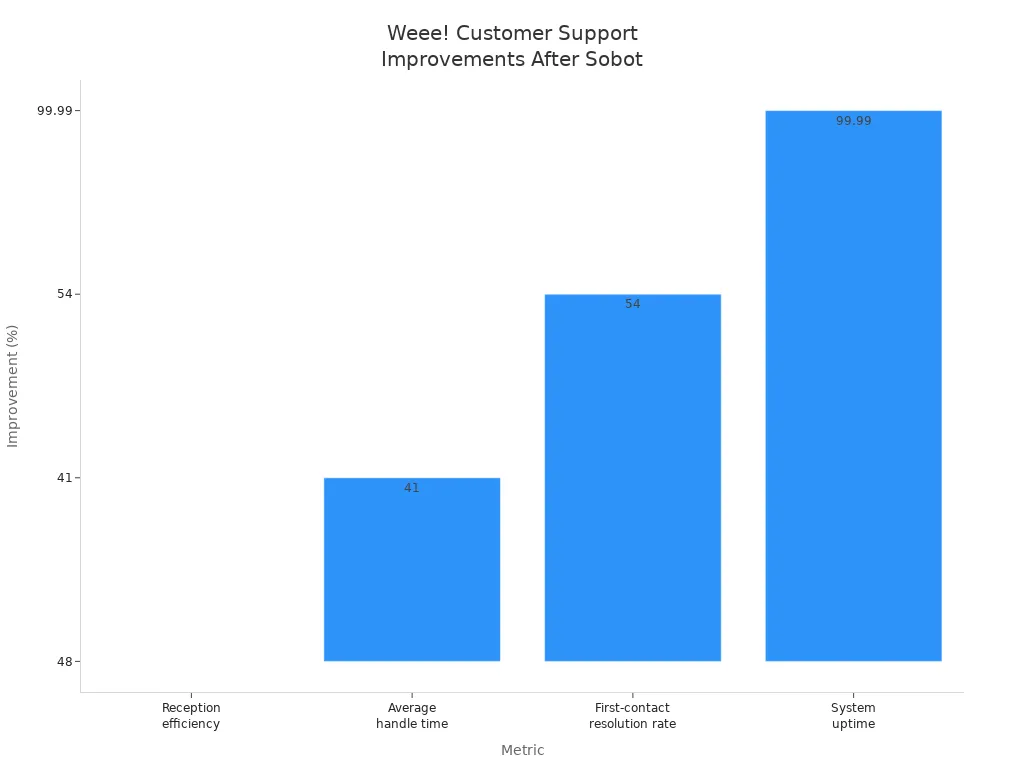Steps to Automate E Commerce Customer Support in 2025

Ecommerce businesses face a new reality in 2025: 95% of customer interactions now use AI-powered solutions. You see faster response times, lower costs, and stronger customer loyalty when you automate e commerce customer support. Sobot AI, including the Sobot call center and chatbot, helps ecommerce brands achieve 24/7 support and up to 80% automation of routine inquiries. The table below highlights how automation shapes e commerce customer support:
| Metric / Statistic | Value / Projection |
|---|---|
| AI-powered customer interactions | 95% |
| Routine inquiries managed by chatbots | Up to 80% |
| Conversion rate increase with chatbots | Up to 5 times |
Why Automate E Commerce Customer Support

Benefits for Ecommerce Businesses
You face more customer questions every year as ecommerce grows. E-commerce customer service automation helps you manage these rising demands with ease. Many e-commerce businesses choose automation for several reasons:
- You can handle more pre-sale, post-sale, and refund questions without hiring more staff.
- Automation takes care of repetitive tasks like ticket assignment, status updates, and sorting, so your team can focus on complex issues.
- You get instant responses for common questions, which saves time for both you and your customers.
- Automated customer support systems can reduce your service costs by up to 30%. Retailers using e-commerce customer service automation often see a 25% drop in operational costs within a year.
- You improve your customer experience by offering faster, more accurate answers. This leads to higher customer satisfaction and loyalty.
Sobot’s AI-powered chatbot and omnichannel platform let you automate up to 80% of routine ecommerce customer service tasks. You can provide 24/7 support, answer questions in multiple languages, and keep your customers happy at any time.
When you use e-commerce customer service automation, you also build a better business reputation. Customers remember quick, helpful service and are more likely to return.
Trends in E-Commerce Customer Service Automation
Ecommerce customer service automation is changing fast in 2025. You now see AI chatbots and virtual assistants that use natural language processing to answer complex questions. These tools give you 24/7 support and real-time responses, which means your customers never have to wait.
Here are some key trends shaping ecommerce customer service:
- 24/7 availability: Automated customer service lets you help customers any time, day or night.
- Increased productivity: Automation speeds up ticket resolution and frees your agents for more important tasks.
- Real-time responses: You reduce errors and wait times with instant answers.
- Centralized platforms: You can manage all your ecommerce customer service channels in one place, making your team more efficient.
- Empowered customers: Self-service portals and chatbots allow customers to solve problems on their own.
AI-driven e-commerce customer service automation also focuses on trust and privacy. You can balance personalized service with data protection. Sobot’s solutions, for example, use secure AI to keep customer data safe while delivering a seamless customer experience. As more e-commerce businesses adopt these tools, you gain a competitive edge and improve your customer support quality.
Identify Processes for Automation
Mapping Ecommerce Customer Service Workflows
You need to understand your ecommerce customer service workflows before you automate e-commerce customer service. Start by mapping every step your customers take when they reach out for help. This includes order questions, returns, complaints, and feedback. Create a visual flowchart that shows each action, from receiving an order to resolving a complaint. This helps you see where customer service automation can make the biggest impact.
Organize customer queries by type, such as shipping, refunds, or product information. Use scripts and templates for common questions. Set up a system to sort and prioritize tickets, so urgent issues get fast attention. Batch similar tickets together to handle them quickly. When you map your workflows, you spot bottlenecks and delays. For example, manual order entry often causes errors and slowdowns. Automation fixes these issues by speeding up order processing and sending instant updates to customers.
Here is a table showing how workflow mapping improves ecommerce customer service automation:
| Workflow Stage | How Workflow Mapping Improves Customer Support Automation |
|---|---|
| Receiving Orders | Finds manual steps that cause errors; automation ensures fast, accurate order entry. |
| Addressing Complaints | Shows where delays happen; automation gives quick, proactive responses. |
| Refunds and Returns | Spots slow manual processes; automation speeds up refunds and keeps customers happy. |
| Fulfillment | Maps stock and shipping; automation manages updates and communication. |
Tip: Involve your team and customers when mapping workflows. Their feedback helps you find pain points and improve the process.
Selecting Tasks for Automation
After mapping your workflows, choose which ecommerce customer service tasks to automate. Focus on high-volume, repetitive jobs first. These include answering FAQs, tracking orders, and resetting passwords. AI-powered chatbots like Sobot’s can handle these tasks 24/7, giving instant answers and freeing your team for complex issues.
Use this table to help decide which tasks to automate:
| Criteria for Automation | Characteristics | Examples | Why Automate |
|---|---|---|---|
| Repetitive and High-Volume Tasks | Standardized, frequent | Order tracking, FAQs | Saves time, reduces errors |
| Rule-Based and Predictable Processes | Clear rules, little judgment | Refund approvals, compliance | Ensures accuracy, lowers manual work |
| Time-Consuming but Low-Value Tasks | Necessary, not revenue-generating | Email sorting, scheduling | Frees staff for important work |
| Fast Turnaround Times Required | Speed is critical | Instant reporting, order status | Improves customer experience |
By 2025, AI powers 95% of ecommerce customer service interactions. Many stores use automation for ticketing, chatbots, and self-service portals. This boosts first-time resolution rates by 37% and lets your team focus on more valuable work. Sobot’s AI chatbot, for example, helps automate e-commerce customer service by handling routine questions and integrating with your ticketing system. This approach improves efficiency and customer satisfaction.
Choosing Tools for E-Commerce Customer Service Automation

Selecting the right tools for ecommerce customer service automation shapes your business success in 2025. You need solutions that handle high volumes, support multiple channels, and deliver fast, accurate responses. The right tools help you automate ecommerce phone support, manage tickets, and empower customers with self-service options. Let’s explore how you can make the best choices for your ecommerce business.
Sobot Chatbot and Omnichannel Solutions

You want a platform that brings all your ecommerce customer service channels together. Sobot offers an all-in-one AI contact center that unifies chat, email, phone, social media, and messaging apps. This means you can manage every customer conversation in one place, making your team more efficient and your customers happier.
Sobot’s chatbot stands out because it uses advanced conversational AI and sentiment analysis. The chatbot understands customer emotions and responds in real time. You can connect Sobot to your website, mobile app, WhatsApp, SMS, and social media. This lets you give real-time order updates, process returns, and recommend products instantly.
Sobot supports over 50 languages, so you can serve customers around the world without hiring extra staff. Multilingual support increases customer loyalty, with 70% of shoppers feeling more loyal to brands that speak their language.
Sobot’s AI chatbots handle up to 80% of routine ecommerce customer service questions. They provide 24/7 support, answer FAQs, and escalate complex issues to human agents when needed. For example, Samsung achieved a 97% customer satisfaction rate using Sobot’s multilingual and real-time insights. OPPO saw an 83% chatbot resolution rate and a 57% increase in repurchase rates after adopting Sobot.
When you choose Sobot, you also get scalable pricing and flexible options. The platform grows with your business, handling more users and tickets during peak seasons without slowing down. Sobot’s integration with popular ecommerce and CRM platforms ensures you can connect your existing systems easily.
Here are key features to look for in ecommerce customer service tools:
- AI-powered chatbots that provide 24/7 personalized assistance and handle large query volumes.
- Centralized inbox to manage messages from all channels.
- Automated ticketing to categorize and assign queries quickly.
- Seamless integration with ecommerce, CRM, and payment systems.
- Multilingual support for global reach.
- Real-time analytics and reporting dashboards.
- Customizable workflows and templates.
- Secure data handling and compliance with privacy regulations.
Tip: Choose a platform that offers a point-and-click interface. This makes it easy for your team to set up and manage automations without coding.
Integrating Self-Service Options
Self-service options are essential for modern ecommerce customer service. You empower customers to solve problems on their own, which reduces the workload for your agents and speeds up resolutions. Sobot’s self-service portal connects to your knowledge base, letting customers find answers to common questions, track orders, and manage returns anytime.
AI chatbots play a big role in self-service. They guide customers through routine tasks like checking order status, resetting passwords, or updating shipping details. This means your team can focus on complex issues that need a human touch.
Here’s how self-service options improve ecommerce customer service:
- Customers resolve issues independently, such as order tracking and account management.
- 24/7 availability means customers get help anytime, even outside business hours.
- Faster resolutions lead to higher satisfaction and fewer support tickets.
- Agents spend less time on repetitive questions and more time on unique cases.
- Cost efficiency improves as automation handles routine tasks.
- Personalized automated messages keep customers engaged using their names and purchase history.
A self-service portal also helps you scale support without hiring more staff. For example, companies using self-service tools have seen up to a 76% reduction in ticket volume and a 96% customer satisfaction score. The best approach combines self-service portals, AI-driven automation, and unified communication channels.
Note: 77% of consumers say difficulty reaching an agent is a major issue. Make sure your self-service options always offer an easy way to escalate to a human agent when needed.
Automated Ticketing and CRM Integration
Automated ticketing systems are vital for efficient ecommerce customer service. They create, classify, and route tickets automatically, ensuring every inquiry reaches the right agent fast. Sobot’s ticketing system uses AI to prioritize urgent issues, manage SLAs, and provide real-time suggestions to agents.
AI-powered phone support and chatbots with AI can auto-resolve common queries, reducing manual triage time. When a ticket needs human attention, the system routes it based on customer sentiment and profile. This speeds up handling and improves customer satisfaction.
Integrating your ticketing system with CRM tools brings even more benefits. Your agents can access customer purchase history and preferences instantly. This allows for quick, personalized responses and better experiences. Centralized customer data also helps you make data-driven decisions and improve your marketing strategies.
Here’s what you gain from automated ticketing and CRM integration:
- Streamlined operations with less manual effort.
- Faster resolution of customer queries.
- Personalized support using customer history.
- Enhanced collaboration across sales, marketing, and support teams.
- Better insights from analytics dashboards.
- Increased revenue through improved retention and upselling.
Sobot’s platform supports deep integration with ecommerce platforms, CRM systems, and third-party tools. You can customize chatbot flows, automate workflows, and monitor performance with real-time analytics. The system also supports role-based access control and secure data handling, keeping your customer information safe.
AI automation in ticketing and CRM integration boosts agent productivity by up to 80% and reduces mean time to resolve by as much as 90%. This leads to happier customers and a more efficient support team.
Practical Tips for Selecting and Integrating Automation Tools
When choosing ecommerce customer service tools, keep these tips in mind:
- Look for ease of use. A simple interface helps your team adopt new tools quickly.
- Make sure the platform scales with your business. You need to handle more tickets and users during busy times.
- Prioritize multilingual support to reach global customers.
- Choose tools that integrate with your existing ecommerce, CRM, and payment systems.
- Check for customizable workflows and templates to match your business needs.
- Ensure the platform offers strong security and compliance features.
- Use analytics and reporting to track performance and optimize your support operations.
A well-chosen solution like Sobot helps you automate ecommerce phone support, deliver ai-powered phone support, and provide excellent customer self-service options. You improve efficiency, reduce costs, and keep your customers coming back.
Setting Up and Optimizing Automation
Workflow Automation Rules
You can set up workflows to automate e-commerce customer service and boost efficiency. Start by naming your automation rule and activating it. Choose the channels where the rule will work, such as chat or email. Define when the rule should trigger, like when a new ticket is created or a message contains certain keywords. Next, decide what action the system should take, such as assigning the ticket to a team member or tagging it for easy sorting. Save the rule to put it into action.
Automation rules help you categorize tickets, reduce manual errors, and speed up responses. For example, Sobot’s platform lets you automate ticket routing and use ai chatbots to answer common questions instantly.
To optimize your workflows, use these strategies:
- Employ ai-powered chatbots and automated ticketing to respond quickly.
- Categorize and assign tickets automatically.
- Use self-service options to empower customers.
- Monitor key metrics like customer satisfaction and order times.
- Refine your automation as your business grows.
Personalization and Multilingual Support
Personalization shapes every part of customer-focused support. AI chatbots can generate product recommendations, emails, and website content tailored to each customer. Machine learning studies customer behavior to offer dynamic suggestions. Personalization boosts customer experience, loyalty, and sales.
You can automate e-commerce customer service while still making each interaction feel unique. Use customer data to personalize messages, reference past purchases, and adjust language. Always blend automation with a human touch to avoid robotic responses.
Multilingual support expands your reach. Start by analyzing which languages your customers use. Localize content, not just translate it. Use ai-powered chatbots and real-time translation tools to provide accurate support in many languages. Sobot’s chatbot supports over 50 languages, helping you deliver seamless customer experience worldwide.
Testing and Analytics
Testing and analytics help you measure and improve your automated workflows. Track metrics like first response time, self-service usage, and customer satisfaction. Use analytics to spot pain points and optimize your support channels. For example, Sobot’s reporting tools let you see which workflows work best and where you can improve.
By measuring KPIs such as Net Promoter Score and Customer Effort Score, you can refine your automation and deliver better customer experience.
Real-World Success: Sobot in Ecommerce Customer Support
Weee! Case Study
You can see the power of automation in action with Weee!, America’s largest online Asian supermarket. Weee! faced challenges with high inquiry volumes, language barriers, and slow response times. The company wanted to improve customer satisfaction and make support more efficient. By choosing Sobot’s AI-powered contact center, Weee! unified its customer service channels and introduced multilingual support.
Sobot’s flexible IVR system and integrated workbench helped Weee! agents manage calls, chats, and tickets from one place. The platform’s multilingual templates allowed agents to serve customers in their preferred language. Sobot’s open API made it easy for Weee! to connect with its CRM and other tech systems. This setup gave Weee! a strong foundation for fast, reliable support.
Key Results and Takeaways
After implementing Sobot, Weee! saw impressive improvements in its support operations. The table below shows the measurable gains:
| Metric | Improvement |
|---|---|
| Reception efficiency | Increased by 48% |
| Average handle time | Reduced by 41% |
| First-contact resolution rate | Improved by 54% |
| Net Promoter Score (NPS) | Increased |
| System uptime | Reached 99.99% |
| Integration speed | Fast and simple |

You benefit from these results in several ways. Faster response times and higher first-contact resolution rates lead to better customer satisfaction. When your agents work more efficiently, your customers get the help they need without long waits. Sobot’s reliable system uptime means your support is always available. You can also scale your support as your business grows.
Sobot’s solutions help you build trust and boost customer satisfaction. You create a seamless support experience that keeps shoppers coming back.
You can automate e commerce customer support by mapping workflows, choosing smart tools, and focusing on personalization. Sobot Chatbot helps you deliver 24/7 support, improve personalization, and boost customer satisfaction. Personalization lets you answer questions in many languages and tailor every reply. You see higher customer satisfaction and more repeat buyers when you use personalization in e commerce customer support. Start your automation journey with Sobot to unlock the power of personalization. Explore Sobot’s solutions or contact their team for more details.
FAQ
How can you start to automate e commerce customer support?
You can begin by mapping your customer service workflows. Identify repetitive tasks like order tracking or FAQs. Choose a tool like Sobot Chatbot, which requires no coding. Sobot helps you automate e commerce customer support quickly and easily.
What are the main benefits when you automate e commerce customer support?
You save time and money. Sobot’s AI Chatbot can handle up to 80% of routine questions. Your team focuses on complex issues. Customers get faster answers. Businesses using automation often see a 25% drop in service costs. Source
Does Sobot support multilingual automation for e commerce customer support?
Yes! Sobot Chatbot supports over 50 languages. You can automate e commerce customer support for customers worldwide. Multilingual support increases loyalty. For example, 70% of shoppers feel more loyal to brands that speak their language.
Can you integrate Sobot with your existing e commerce platforms?
You can connect Sobot with popular e commerce and CRM systems. Sobot’s open API makes integration simple. This helps you automate e commerce customer support across all your channels and keep customer data in one place.
Tip: Automate e commerce customer support with Sobot to boost efficiency and customer satisfaction.
See Also
A Complete Guide To Deploy Omnichannel Contact Centers
How To Effectively Utilize Shopify Live Chat Support
Ways Ecommerce Live Chat Tools Increase Online Revenue
